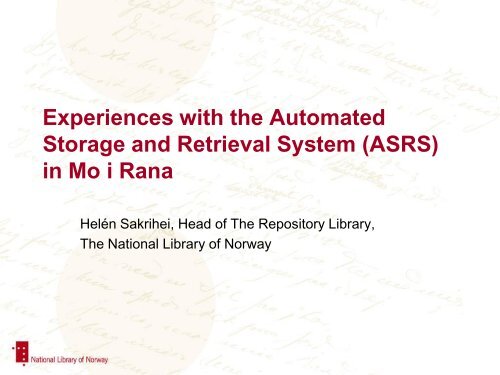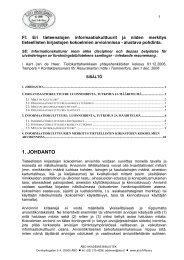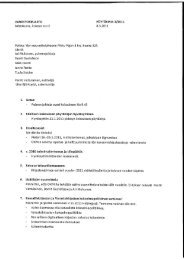The Automatic Storage and Retrieval System - Varastokirjasto
The Automatic Storage and Retrieval System - Varastokirjasto
The Automatic Storage and Retrieval System - Varastokirjasto
You also want an ePaper? Increase the reach of your titles
YUMPU automatically turns print PDFs into web optimized ePapers that Google loves.
Experiences with the Automated<br />
<strong>Storage</strong> <strong>and</strong> <strong>Retrieval</strong> <strong>System</strong> (ASRS)<br />
in Mo i Rana<br />
Helén Sakrihei, Head of <strong>The</strong> Repository Library,<br />
<strong>The</strong> National Library of Norway
<strong>The</strong> Repository Library<br />
• Established in 1989<br />
• Staff: 17 employees<br />
• Interlending per year:<br />
100,000 documents<br />
• Aquisition per year:<br />
100 – 200,000 documents<br />
2
<strong>The</strong> Repository Library<br />
• Collection:<br />
• 780,000 monographs<br />
• 1,5 million issues<br />
of periodicals<br />
• 50,000 microfilms<br />
• Audio books<br />
• Music CDs<br />
3
Why <strong>Automatic</strong> <strong>Storage</strong> <strong>and</strong> <strong>Retrieval</strong><br />
<strong>System</strong>?<br />
• In 1996 the NL started to plan a new<br />
storage for <strong>The</strong> RL, <strong>and</strong> investigated<br />
the possibilities for building an ASRS<br />
• Advantages<br />
• Traditional storage would cost more<br />
to build (15 – 20 million NOK)<br />
• Operation expenses would be lower<br />
• ASRS would require 20-25% of the<br />
base area of a traditional storage<br />
4
Why <strong>Automatic</strong> <strong>Storage</strong>?<br />
• <strong>The</strong> ASRS would be based on a<br />
well known tecnhology used<br />
by companies such as Lego,<br />
Husquarna etc. etc.<br />
5
Why <strong>Automatic</strong> <strong>Storage</strong>?<br />
Disadvantages:<br />
- <strong>The</strong> mechanics would make<br />
<strong>The</strong> ASRS vulnerable<br />
- Would it be noisy?<br />
- Operating <strong>The</strong> ASRS<br />
would be monotonous?<br />
- Books could disappear<br />
when they didn’t have a<br />
permanent place on a shelf?<br />
6
Moving into the ASRS<br />
• In 2000 <strong>The</strong> Ministry of Culture<br />
<strong>and</strong> Church Affairs accepted our<br />
plans for building an ASRS with<br />
a maximum cost of 100 million NOK.<br />
• <strong>The</strong> RL closed temporarily in<br />
October 2002.<br />
• Within 15 months we moved most<br />
of the collection into <strong>The</strong> ASRS.<br />
• Reopened June 2003<br />
7
<strong>The</strong> <strong>Automatic</strong> <strong>Storage</strong> <strong>and</strong> <strong>Retrieval</strong><br />
<strong>System</strong> (ASRS)<br />
• 41 500 steel boxes<br />
• folders<br />
• Three gangways<br />
• Three <strong>Automatic</strong> Miniload<br />
Cranes<br />
• 200 boxes in/out per hour<br />
• R<strong>and</strong>om storage<br />
8
R<strong>and</strong>om storage<br />
9
R<strong>and</strong>om storage<br />
• No permanent box or folder<br />
• No permanent location<br />
• Each location has an coordinate<br />
• Barcodes<br />
• Attached to each other in the<br />
Warehouse Management<br />
<strong>System</strong> (WMS)<br />
10
How does it work?<br />
• Every morning loan orders are<br />
sent from Bibsys to<br />
WMS.<br />
• <strong>The</strong> cranes fetch the boxes which<br />
contain ordered material<br />
• <strong>The</strong> boxes are brought to<br />
the pick up stations in the <strong>Retrieval</strong><br />
Centre<br />
11
How does it work?<br />
• <strong>The</strong> operators read the barcode on<br />
the publication, <strong>and</strong> both WMS <strong>and</strong><br />
Bibsys are updated<br />
• Some orders require<br />
manual work:<br />
- microfilms<br />
- article copies<br />
- multi-volume publications<br />
12
Operation stability<br />
• 160,000 items out <strong>and</strong> 220,000<br />
items in to storage per year<br />
• High operation stability<br />
• Automation engineer who<br />
maintains the hardware<br />
• Four of our co-workers have been<br />
special trained in ASRS/WMS<br />
• Service on <strong>Storage</strong> once a year<br />
13
How has <strong>The</strong> ASRS changed the way we<br />
work?<br />
• <strong>The</strong> need of manpower to carry out<br />
our loanorders has been reduced to<br />
1/3.<br />
• More capacity to other tasks, such as<br />
cataloguing<br />
• New tasks:<br />
- books to digitization<br />
14
Collection control<br />
• Coordinated shelf lists from Bibsys <strong>and</strong> Swisslog<br />
• In order to find books in storage that aren’t registrated<br />
in the catalogue, <strong>and</strong> books in the catalogue that aren’t<br />
in storage<br />
15
Problems…<br />
• When errors do occur,<br />
we often manage to solve them klarer vi som<br />
ourselves<br />
• Depend on a good support<br />
agreement<br />
• Hardware problems – the RL<br />
• Software problems – Swisslogg<br />
• Spare parts<br />
16
Conclusion<br />
• <strong>The</strong> ASRS has given us easy access<br />
to our collection <strong>and</strong> made us able<br />
to carry out all loan orders<br />
within 24 hours<br />
• From time to time we do have<br />
shutdowns, but all in all the<br />
operation stability is high<br />
• Books can disappear, but more<br />
seldom than from traditional bookshelves<br />
17
Plans<br />
• By 2012 todays storage is filled<br />
• Now we are planlegging the next<br />
storage<br />
• known technology<br />
• use existing infrastructure<br />
• easy to build<br />
18
Kiitos…<br />
helen.sakrihei@nb.no<br />
19













